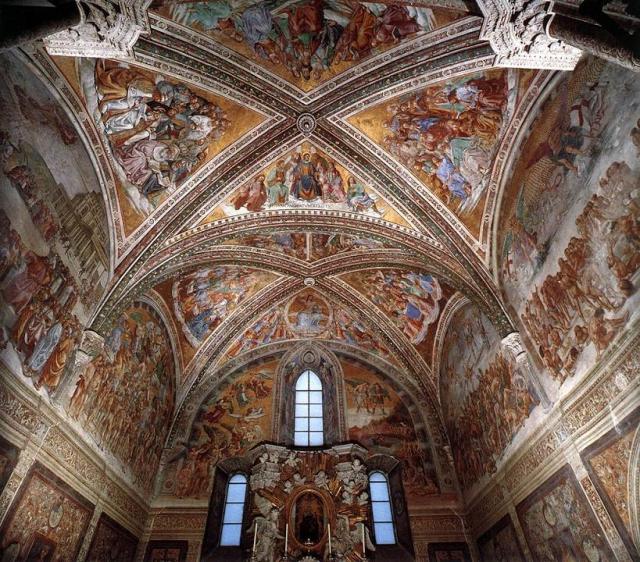Luca Signorelli’s frescoes of ‘The Last Judgement’ in the Cappella di San Brizio in the Duomo of Orvieto is claimed by some to equal or exceed Michelangelo’s famous version of that story painted on the end wall of the Sistine Chapel in the Vatican. Having now been fortunate enough to see both, I’ll pick Signorelli’s work. Although Michelangelo’s Sistine ceiling is superb, I’ve always thought his ‘Last Judgement’ to be a bit over-rated – rather grim, a writhing and a creaking air to it (even considering that a pious Pope had someone later paint decorous bits of clothing over the naughty bits of the completely naked figures of Michelangelo). Signorelli’s frescoes have more lightness, and more narrative, I think. Recently restored, they have a freshness to the eye, and an absorbing narrative. I managed a crick on my neck from staring at them. Entrancing. Continue reading
Tag Archives: Umbria
Orvieto’s Duomo
 |
| Duomo of Orvieto |
I could apologise for including in this post so many photos of the facade of the Duomo in Orvieto (an Umbrian town), but I think it’s justified. That moment when it bursts upon you as you walk through the narrow alley-like streets of the medieval town – magic. You’re in dark shadows, you look up, and gasp when the shimmer of the facade glows between the tall buildings. Continue reading
The Umbrian Countryside
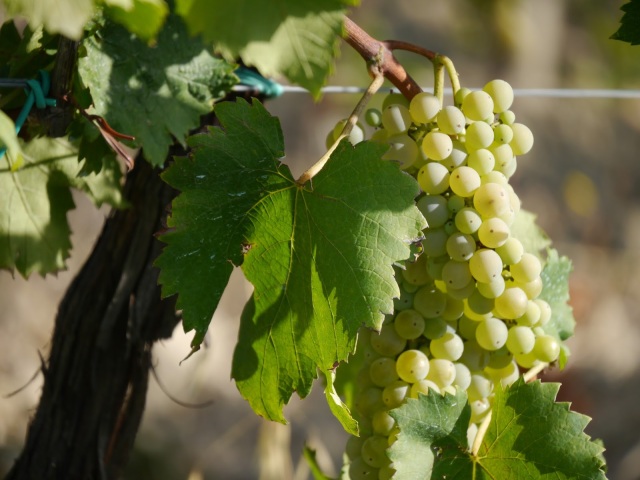 |
| Orvieto Classico on the vine. |
Umbria, the only province of Italy without a sea coast, is a prime attraction for travellers looking for the countryside of Italy. Along with its neighbouring province of Tuscany, it’s the go-to area for hiring a casa di campana and spending a week eating and drinking well, with a few exquisite treasures of art or history thrown in. Continue reading
Spotting Spoleto
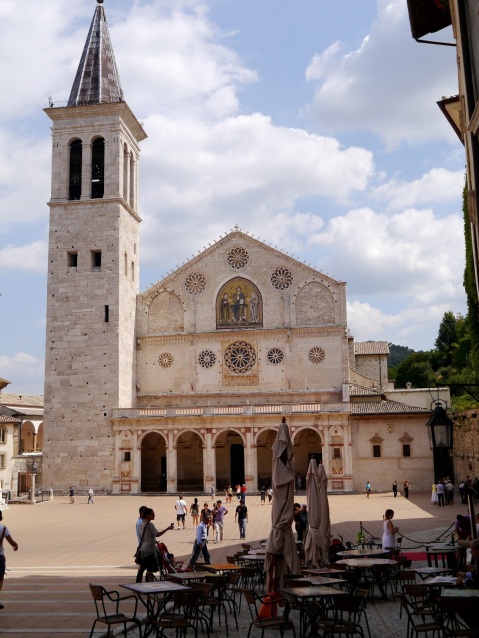 |
| Spoleto’s impressive Duomo. |
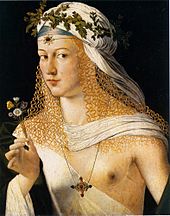 Lucrezia Borgia (maybe) Portrait of a Woman by Bartolomeo Veneto, traditionally assumed to be Lucrezia Borgia. (source) |
Umbria: another day, another hill town. But this one – Spoleto – has a curious history – in 1499, the notorious Pope Alexander VI, the Borgia Pope, appointed his 19 year old daughter Lucrezia governor of the town. She acted in this capacity, apparently quite well, until 1502. Perhaps she lived in The Rocca, the castle on the hill, and reached it via the tall Ponte delle Torri, a bridge-cum-aquaduct…
In any event, whatever it was like in Lucrezia’s day, Spoleto is a charming town these days. Lots of narrow medieval streets, well preserved, the odd few Roman left overs (there’s an Arco di Druso that’s quite well-preserved). You can buy Umbrian wool and ceramics, and chic modern art pieces; or stop in cute trattorias or bars. You could, at the right time of the year, linger for Spoleto’s famous Summer Festival. Continue reading
The Twin Benedictines and The Beer
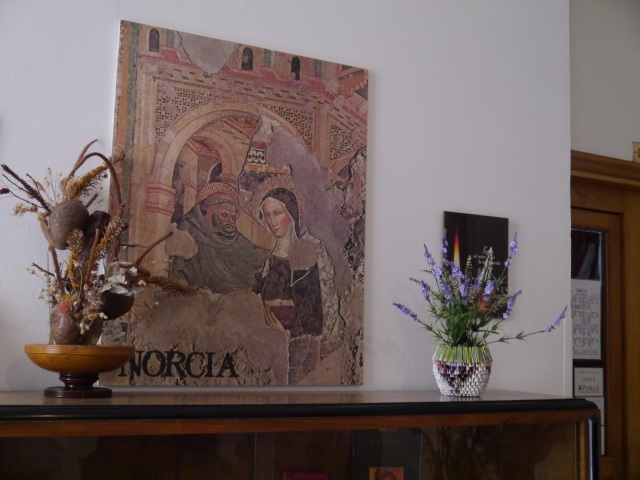 |
| The twin saints: Convent of the Monastero di S. Antonio Abate, Norcia |
The town of Norcia, in Umbria, likes to remind its visitors that it is the birthplace of a great religious personage, Saint Benedict. Benedict was a very influential saint – his ‘Rules’ are generally accepted by most in the monastic movement. He spent a number of years as an eremo (hermit), then founded a great monastery at Monte Cassino, which lies on a hilltop between Rome and Naples. Today, San Benedetto himself stands atop a tall plinth looking over the central piazza of Norcia. Continue reading
The Patron Saint of Lost Causes
 |
| Santa Rita souvenirs. |
In the overwhelming task of figuring out the stories of the Roman Catholic saints – there are too many of them for one lifetime to be long enough – I occasionally come across a particularly revered saint. One such is Santa Rita, known as the patron saint of lost causes. If you have something really appalling to work on, Santa Rita is the gal – particularly if it’s connected with children or husbands, because unusually amongst saints (setting aside the Madonna herself, of course), Santa Rita had both. Continue reading
Piano Grande
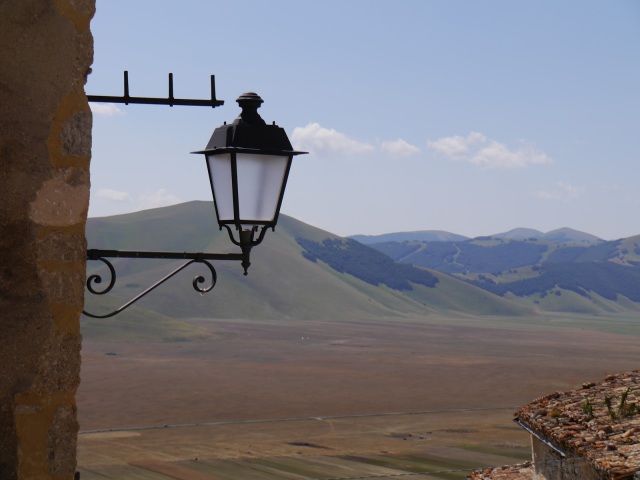 |
| It’s all about the view. |
In the middle of Italy, in the middle of Umbria, there’s a great wide plain that takes your breath away when you see it. Italians drive their caravans and park in the middle of it, break out the deck chairs, lie in them, and absorb it all. Continue reading
Pork and Truffles
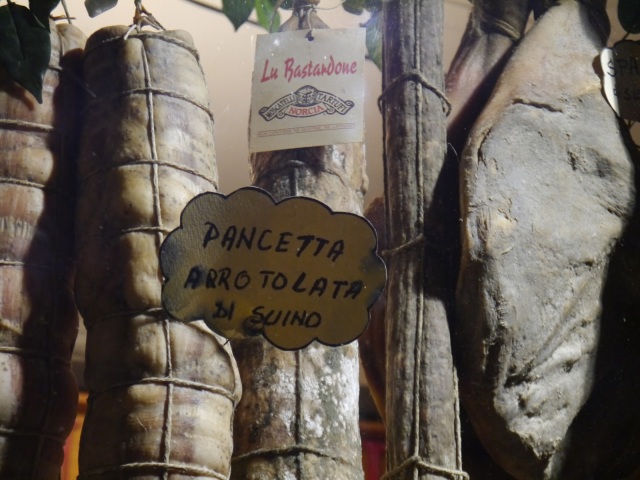 |
| Pancetta! |
Umbria is the only province of Italy that doesn’t have a sea coast. It is full of mountains, on top of which sit medieval hilltop villages; and now and then the mountains open into surprising, broad, fertile plains. This travel article describes the drive through the mountain road tunnel to emerge into the Valnerina, a steep-sided valley through which flows the river Nera. Continue reading
Hermits
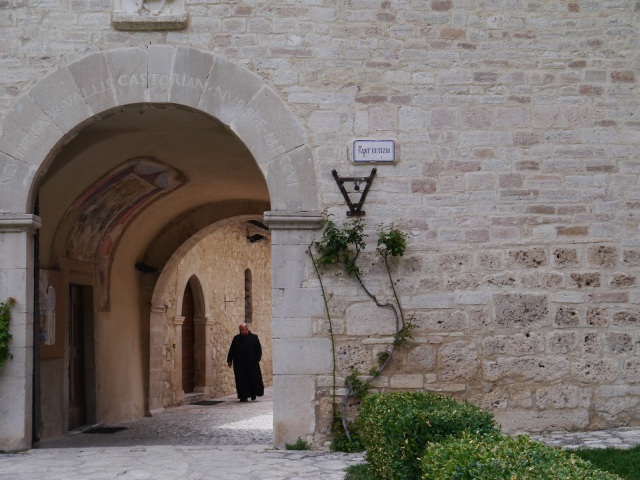 |
| Abbey of Sant’ Eutizio, Umbria |
When Pope Benedict XVI resigned there were news reports that he had spent some time contemplating at the tomb of the only other Pope ever to have resigned on his own initiative, Celestine V in 1294. Celestine’s remains are in the Basilica Santa Maria di Collemaggio in L’Aquila in Abruzzo, central Italy, a city which was seriously damaged by an earthquake in 2009. Continue reading
